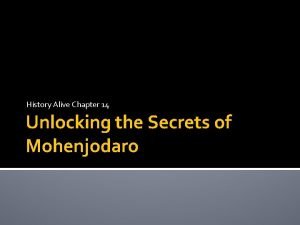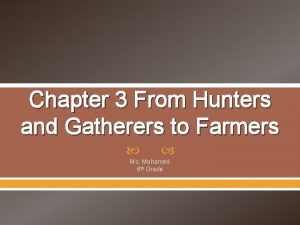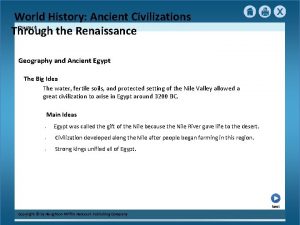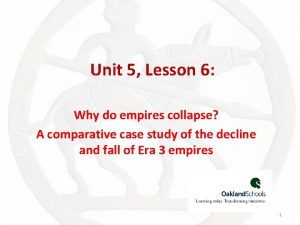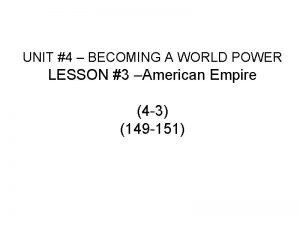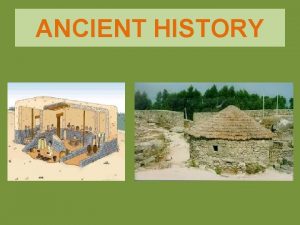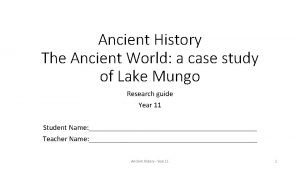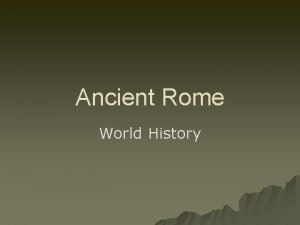WORLD HISTORY ANCIENT UNIT 3 THE WORLD IN








- Slides: 8

WORLD HISTORY- ANCIENT UNIT 3: THE WORLD IN TRANSITION CHAPTER 8: THE BYZANTINE EMPIRE, KIEVAN RUSSIA AND THE MONGOLS While Barbarians plundered the western part of the Roman Empire in the AD 400’s and 500’s, the Byzantine Empire thrived in the East. 1

CHAPTER 8: SECTION 1: THE BYZANTINE EMPIRE A. The Reign of Justinian 1. had an exceptional knack for judging the abilities of others. 2. Theodora parents were in the circus, convinced Justinian to improve the status of women, also convinced him to fight not flee during the Nika Revolt (a) dowry women could own land 3. Belisarius commander of the army 4. Decline after Justinian (a) declined because of external and internal conflicts B. Strengths of the Empire 1. political strength: highly centralized, powerful ruler, arranged marriages 2. military strength : Greek fire, instructional manual 3. economic strength: trade, agriculture, manufacturing flourished 2

CHAPTER 8: SECTION 1: THE BYZANTINE EMPIRE C. The Christian Church 1. Patriarch of Byzantine the most powerful religious leader, didn’t recognize the authority of the Pope in Rome. 2. icons (a) iconoclasts iconstituted idol worship (b) iconoclastic controversy battle over having/not having icons as worship 3. Heresy and excommunication were declared to anyone who practiced iconoclasts D. Byzantine Culture 1. Art was devoted to religion, mosaics (pictures or designs composed of inlaid pieces of stone, glass, or enamel. 2. Architecture, religious and one of their greatest works was The Hagia Sophia 3

CHAPTER 8: SECTION 1: THE BYZANTINE EMPIRE E. The Preservation of Roman Law 1. Corpus juris civilis ( body of civil law) (a) The Digest (b) The Code (c) The Institutes (d) The Novels F. Decline of the Empire 1. Saljuq Turks, and the beginning of the Crusades 2. Fourth Crusade resulted in the west conquering the Byzantine Empire. 4

CHAPTER 8: SECTION 2: THE RISE OF RUSSIA A. Geography 1. The physical geography of this area allowed for easy migration by early people. With a flat, treeless plain (steppe) and many rivers (Vistual, Don, Neman, Dvina, Dniester, Dnieper, Volga, Ural) Ural B. Slavs and Vikings 1. Slavs settle in 200 A. D. - occasionally conquered by Huns, Avars, and Magyars. Vikings Invade 800 s A. D. all groups of which occupied the area for a time. Trade routes. C. The Birth of Kievan Russia (following Viking Invasions) 1. Rurik - military leader of the Rus became the ruler of Novgorod and his dynasty became known as the Rus. 2. Prospered because of their location along the trade route. 3. Other principalities paid tribute to the prince in Kiev in exchange for military protection, their loyalty varied depending on the Kievan prince’s power. 5

CHAPTER 8: SECTION 2: THE RISE OF RUSSIA D. Government 1. Boyars (nobles) were the prince’s advisors 2. Yaroslav the Wise ruled from A. D. 1019 to A. D. 1054, which was a great period in Russian history. He built many churches and introduced Russia’s first law code, known as the Pravda Russkia (Russian justice). E. Religion 1. Christian Missionaries 2. Vladimir and Religion a. Roman vs Eastern Church b. Tolerance of alcohol 3. metropolitan chief Bishop of the Kievan Church F. Economy 1. Agriculture (a) taiga abundant forest with 4 month growing season (b) steppe longer growing season 2. trade G. Social Classes 1. Princes, Boyars, merchants, clergy, artisans and peasants, which made up the largest class of people. 6

CHAPTER 8: SECTION 3: THE RISE OF THE MONGOLS A. The Mongols in Eastern Europe 1. 1237 - Mongols attack 2. 1240 - Mongols had conquered most of Kievan Russia 3. Cross Carpathians, but do not stay in Hungary, Poland B. Kievan Russia Under the Mongols 1. Retained Customs 2. Harsh Taxes 3. Landlords - collected taxes and administered justice 4. Mongol Influence a. Roads b. Language c. Communication d. Taxation 7

CHAPTER 8: SECTION 3: THE RISE OF THE MONGOLS C. Kievan Russia and Its Neighbors 1. Little contact between Eastern and Western Slavs 2. Mistrust and Religious conflict remains even today, west influenced by western Christianity and the east influenced by Greek Orthodox faith. D. The Rise of Moscow 1. Ivan the Great (III) overthrew Mongol rule, est. absolute monarchy. 2. Ivan the Terrible (IV) only 3 years old, ruled by Boyars at first a. czar (caesar), heir to Roman and Byzantine Empire b. oprickniki ( personal army) E. The Growth of the Church 1. land holding increased as a result of gifts and believe that gift meant heaven 2. Third Rome, would bring spiritual light to the world 3. Beautiful artwork (excessive? ) 8
 History alive the ancient world chapter 8
History alive the ancient world chapter 8 History alive the ancient world chapter 14
History alive the ancient world chapter 14 History alive ancient world chapter 3
History alive ancient world chapter 3 World history ancient civilizations through the renaissance
World history ancient civilizations through the renaissance Ancient and modern means of communication
Ancient and modern means of communication Ancient india vs ancient china
Ancient india vs ancient china World history unit 5 lesson 6
World history unit 5 lesson 6 World history unit 4 lesson 3
World history unit 4 lesson 3 Ap world history chapter 25 africa and the atlantic world
Ap world history chapter 25 africa and the atlantic world

